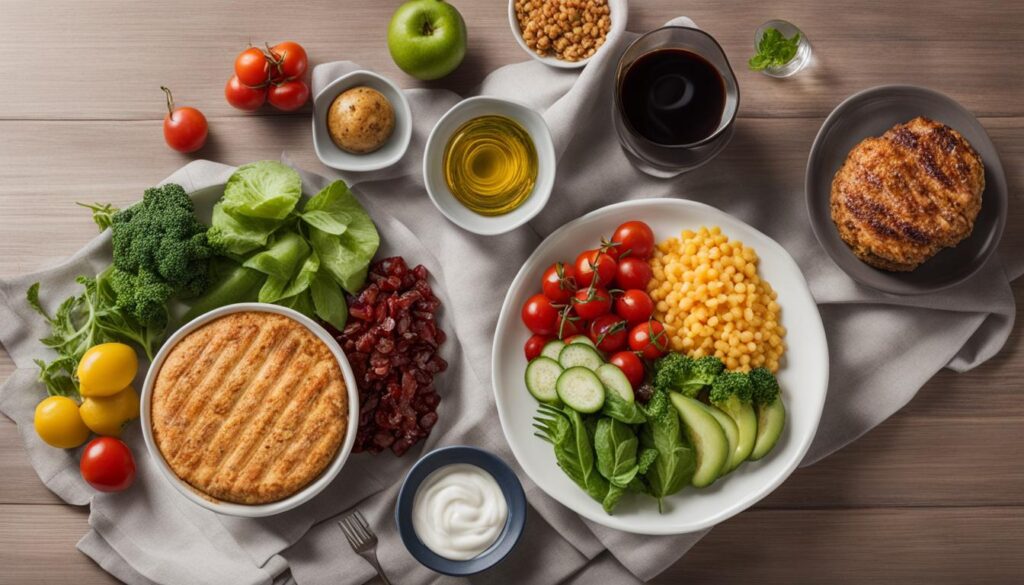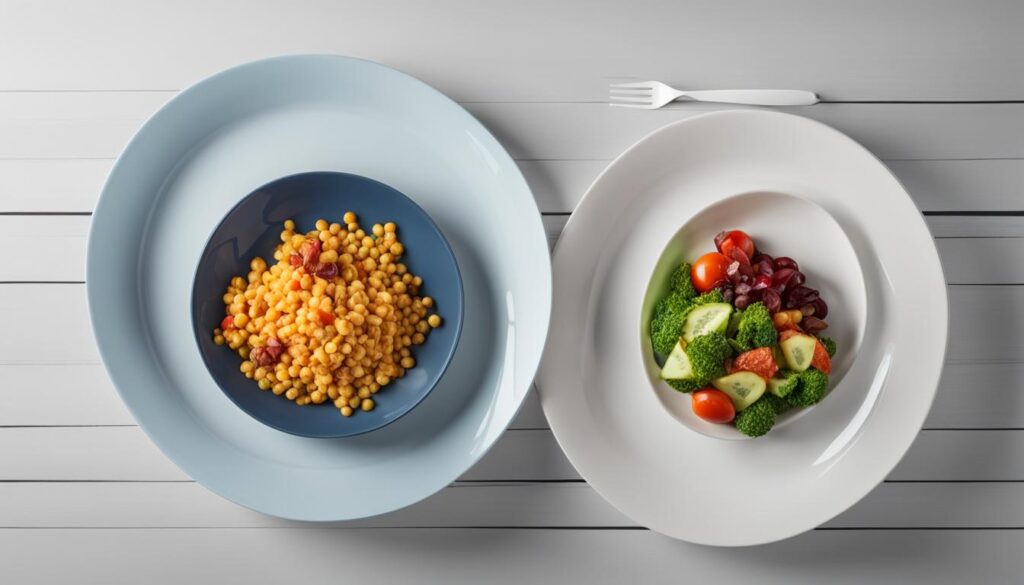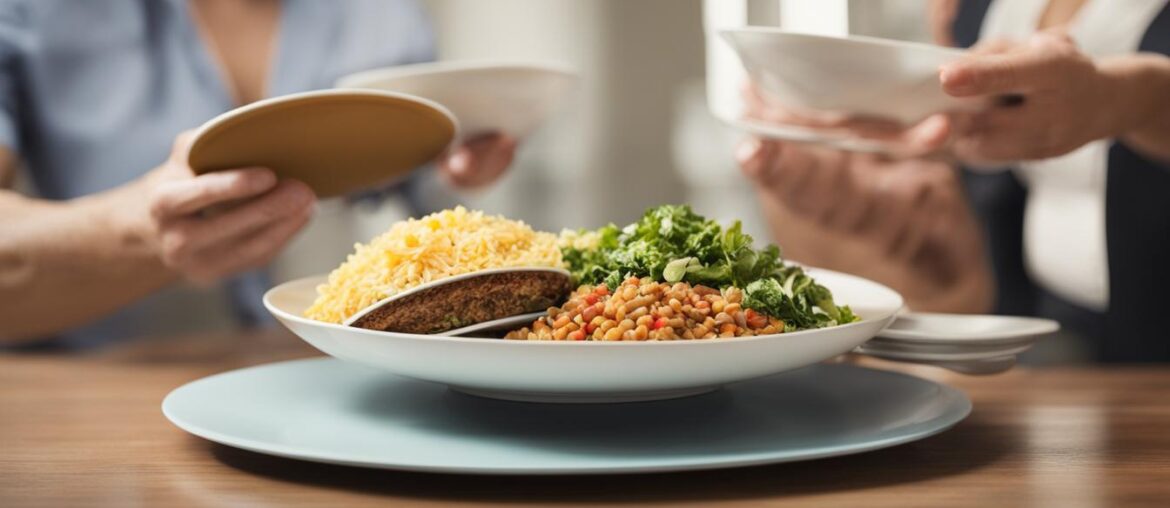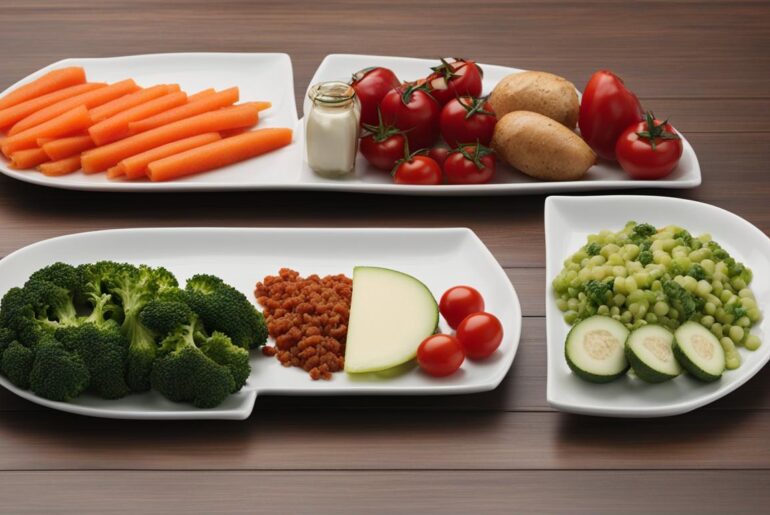When it comes to weight loss, two popular methods are calorie counting and portion control. Calorie counting involves tracking the number of calories consumed each day, while portion control focuses on managing the amount of food consumed. Both methods aim to help individuals eat the right amount of food, but they differ in their approach. In this article, we’ll compare the two methods to determine which one is the most effective for managing a healthy diet.
Key Takeaways:
- Calorie counting and portion control are both effective weight loss techniques.
- Calorie counting involves tracking calories consumed, while portion control focuses on managing the amount of food consumed.
- The choice between calorie counting and portion control depends on individual preferences, lifestyle, and goals.
- Combining calorie counting and portion control can be a comprehensive approach to managing a healthy diet.
- The key is to find a sustainable method that promotes a healthy relationship with food and supports long-term weight management.
How Does Portion Control Work?
Portion control works by providing pre-measured portions of different food groups. Portion control containers, like the Uba portion containers, are color-coded and labeled for specific food groups. By filling each container with the appropriate food group and eating only what fits in the container for each meal, individuals can ensure they are consuming the right amount of each food group. This method takes the guesswork out of portion control and can be especially helpful for those who struggle with overeating or portion distortion.
Portion control containers are designed to make portion control easy and convenient. Each container is specifically sized to hold a pre-measured portion of a particular food group, eliminating the need for weighing or measuring food. This simplifies the process of portion control and makes it more accessible to anyone looking to manage their food intake.
The Uba Portion Control Containers
One popular brand of portion control containers is the Uba portion containers. These containers are made from durable and BPA-free materials, ensuring safe and long-lasting use. The Uba containers come in different sizes and colors, each representing a different food group.
| Food Group | Container Color | Container Size |
|---|---|---|
| Proteins | Red | 8 oz |
| Grains | Yellow | 7 oz |
| Fruits | Purple | 4 oz |
| Vegetables | Green | 5 oz |
| Fats and Oils | Blue | 3 oz |
| Condiments | Orange | 2 oz |
By using the Uba portion containers, individuals can easily fill each container with the recommended portion size for each food group. This allows for a balanced diet and prevents overeating or consuming excessive portions of any particular food group.
Portion control containers provide a visual representation of proper portion sizes, making it easier for individuals to make healthy choices and control their calorie intake.
In addition to using portion control containers, other methods of portion control include using measuring cups and food scales, as well as following portion size guidelines provided by nutrition labels (see my post here). However, portion control containers offer a convenient and foolproof way to manage portion sizes without the need for additional tools or calculations.
Benefits of Portion Control

When it comes to managing a healthy diet, portion control offers numerous benefits. Utilizing portion control containers is a sustainable and convenient method that simplifies the process while eliminating the need to count calories. These containers provide pre-measured portions, making it easier to consume the appropriate amount of each food group without the constant hassle of tracking and calculations.
By using portion control containers, individuals can develop healthier eating habits in the long run as the containers teach them proper portion sizes. This is particularly beneficial for those who struggle with overeating or portion distortion. With portion control, individuals gain a better understanding of their food intake and can make more informed choices about their eating habits.
Benefits Overview:
- Simplifies portion control
- Eliminates the need to count calories
- Provides pre-measured portions
- Teaches proper portion sizes
- Promotes healthier eating habits
Portion control is not only effective for weight management but also supports overall health and well-being. It encourages individuals to consume a balanced diet, ensuring they are getting the right amount of essential nutrients without overindulging.
“Portion control containers have revolutionized the way I approach my meals. They make portion control second nature and help me maintain a healthy eating routine.” – Sarah, Portion Control Advocate
By incorporating portion control into your daily routine, you can achieve portion size regulation and promote a more balanced and sustainable way of eating. It offers a practical method for managing your food intake without the constant stress of calorie counting.
Now that we understand the benefits of portion control, let’s explore how calorie counting works and its role in weight management (see my post here).
How Does Calorie Counting Work?
Calorie counting is a method of weight management that involves tracking the number of calories consumed each day. By diligently monitoring your calorie intake, you can gain a clear picture of your energy intake and make informed decisions about your diet. When practicing calorie counting, individuals calculate the number of calories in each food and beverage they consume and track their daily intake to ensure they are staying within a certain calorie range.
Tracking calories can be an effective tool for weight loss and weight maintenance. It allows you to have a better understanding of how many calories you are consuming and whether you are meeting your dietary goals. Additionally, it can help you identify areas where you may be overindulging or lacking in essential nutrients.
However, it’s important to note that calorie counting can be time-consuming and tedious for some people. Constantly tracking and calculating calories can be a hassle, especially for those with busy lifestyles or limited time for meal preparation. It requires meticulous record-keeping and can become a daunting task over time.
Despite these challenges, calorie counting remains a popular method for managing calorie intake. It provides a structured approach to weight management and allows individuals to make informed choices about their food consumption. By monitoring your calorie intake, you can adjust your diet as needed to achieve your health and wellness goals.
“Calorie counting provides a structured approach to weight management, allowing individuals to make informed choices about their food consumption.”
While some individuals may find the process of counting calories beneficial, others may prefer alternative methods, such as portion control or intuitive eating. It’s important to find a weight management strategy that works best for you, taking into consideration your lifestyle, preferences, and overall well-being.
In the next section, we will discuss the role of portion control in calorie management, and how it offers a simplified alternative to calorie counting.
The Role of Portion Control in Calorie Management

When it comes to managing calorie intake, portion control can be a simpler alternative to calorie counting. By focusing on portion size regulation and implementing calorie control strategies, individuals can effectively manage their calorie intake without the need for constant calculations and tracking.
Portion control allows individuals to learn and adopt proper portion sizes, which in turn promotes healthier eating habits and contributes to long-term weight management. By emphasizing the quantity and quality of the food they consume, individuals can achieve a balanced diet without solely relying on calorie counting.
One method of implementing portion control is by using portion control containers, such as the Uba portion containers. These containers provide pre-measured portions of different food groups, making it easier for individuals to portion their meals. By filling the containers with the appropriate food groups and consuming only what fits in each container for each meal, individuals can ensure they are consuming the right amount of each food group.
Here is an example of a portion control table:
| Food Group | Suggested Portion |
|---|---|
| Protein | 4-6 oz |
| Grains | 1/2 cup |
| Fruits | 1/2 cup |
| Vegetables | 1 cup |
| Dairy | 1 cup |
| Fats | 1 tbsp |
By following portion control guidelines and using tools like portion control containers, individuals can effectively manage their calorie intake and achieve their health and weight goals.
Combining Portion Control and Calorie Counting
When it comes to managing a healthy diet, some individuals may find success by combining the benefits of portion control and calorie counting. By utilizing portion control containers or other portion control methods, individuals can ensure they are eating the right amount of each food group (see my post here). Simultaneously, by tracking their calorie intake, they can gain awareness of their energy intake and support their specific weight loss goals.
Combining portion control and calorie counting allows for a more comprehensive approach to nutrition tracking. It provides the advantages of portion control, such as simplified portion control and the development of healthier eating habits, while also harnessing the benefits of calorie counting. This combination strategy offers individuals both quantity and quality control over their food choices, fostering a well-rounded approach to managing their nutritional intake.
One popular method of portion control is the use of portion control containers, such as those provided by Uba. These containers are designed to assist individuals in measuring and controlling their food portions accurately. By using these containers in conjunction with calorie tracking, individuals can maintain portion control while also monitoring their calorie intake to ensure they stay within their desired range.
“Combining portion control and calorie counting allows for a more comprehensive approach to managing a healthy diet.”
By combining portion control and calorie counting, individuals can find a balance that works best for them. This approach provides the structure and guidance of portion control, ensuring that individuals are not overeating or under-eating. Simultaneously, calorie counting offers the advantage of awareness and precision in managing energy intake. Together, these methods offer a powerful tool for effective weight management (check this post out).
It is important to note that combining portion control and calorie counting may not be suitable or necessary for everyone. Some individuals may find success with one method exclusively, while others may prefer to focus on portion control or calorie counting alone. The choice ultimately depends on personal preferences, lifestyle, and goals.
Benefits of Combining Portion Control and Calorie Counting
Combining portion control and calorie counting offers several advantages for individuals seeking effective weight management:
- Increased awareness of food portions and nutritional intake
- Development of healthier eating habits
- Ability to customize meal plans based on individual calorie goals
- Supports precise tracking of calorie intake
- Provides a more comprehensive approach to managing a healthy diet
By capitalizing on the benefits of both portion control and calorie counting, individuals can optimize their weight loss efforts while maintaining a nutritious and well-balanced diet.
Conclusion
In the quest for effective weight management and successful weight loss strategies, both calorie counting and portion control have proven to be beneficial methods for maintaining a healthy diet. Each approach offers its own unique advantages and can contribute to achieving weight management goals.
Calorie counting involves diligently tracking the number of calories consumed daily, providing individuals with a clear understanding of their energy intake. This method can be particularly helpful for those who prefer a structured approach and enjoy analyzing data. On the other hand, portion control focuses on managing the quantity of food consumed, offering a more simplified and intuitive method. Portion control containers or other portion size regulation techniques help individuals learn proper portion sizes, promoting healthier eating habits in the long run.
The choice between calorie counting and portion control ultimately hinges upon individual preferences, lifestyle, and weight management goals. Some individuals may find success with one method over the other, while others may prefer to combine both approaches for a comprehensive and personalized strategy. The key is to find a sustainable approach that establishes a healthy relationship with food and supports long-term weight management.
Whether you opt for calorie counting, portion control, or a combination of both, the most important aspect is finding a method that works for you. By adopting effective weight management strategies that suit your lifestyle, you can achieve your weight loss goals and maintain a healthy diet in the long term.




